transmission oil JEEP CJ 1953 Owner's Manual
[x] Cancel search | Manufacturer: JEEP, Model Year: 1953, Model line: CJ, Model: JEEP CJ 1953Pages: 376, PDF Size: 19.96 MB
Page 232 of 376
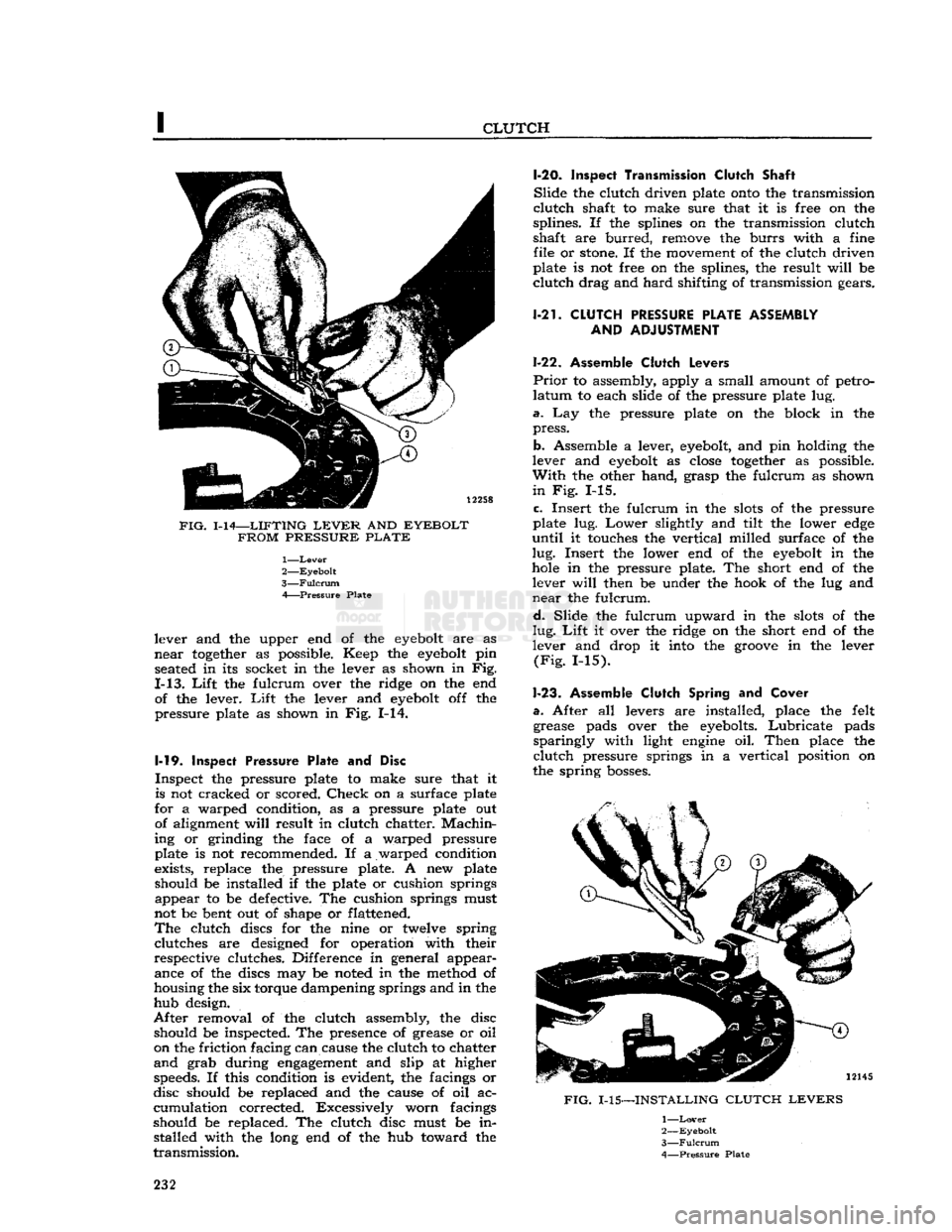
CLUTCH
FIG.
1-14—LIFTING
LEVER
AND
EYEBOLT FROM PRESSURE PLATE
1—
Lever
2—
Eyebolt
3—
Fulcrum
A Pressure Plate
lever and the upper end of the
eyebolt
are as
near
together
as possible. Keep the
eyebolt
pin seated in its socket in the lever as shown in Fig.
1-13.
Lift
the fulcrum over the ridge on the end of the lever.
Lift
the lever and
eyebolt
off the
pressure plate as shown in Fig. 1-14.
1-19.
Inspect
Pressure Plate and Disc
Inspect the pressure plate to make sure that it is not cracked or scored.
Check
on a surface plate
for a warped condition, as a pressure plate out of alignment
will
result in clutch chatter.
Machin
ing or grinding the face of a warped pressure
plate is not recommended. If a warped condition
exists, replace the pressure plate. A new plate
should be installed if the plate or cushion springs appear to be defective. The cushion springs must
not be bent out of shape or flattened.
The
clutch discs for the nine or twelve spring clutches are designed for operation with their
respective clutches. Difference in general appear ance of the discs may be noted in the method of
housing the six torque dampening springs and in the
hub design.
After
removal of the clutch assembly, the disc should be inspected. The presence of grease or oil
on the friction facing can cause the clutch to chatter
and
grab during
engagement
and slip at higher speeds. If this condition is evident, the facings or
disc should be replaced and the cause of oil ac
cumulation corrected. Excessively worn facings
should be replaced. The clutch disc must be in stalled with the long end of the hub toward the
transmission.
1-20.
Inspect Transmission Clutch
Shaft
Slide
the clutch driven plate
onto
the transmission
clutch
shaft to make sure that it is free on the
splines. If the splines on the transmission clutch
shaft are
burred,
remove the
burrs
with a fine file or
stone.
If the movement of the clutch driven
plate is not free on the splines, the result
will
be
clutch
drag and
hard
shifting of transmission gears.
1-21.
CLUTCH
PRESSURE
PLATE ASSEMBLY AND
ADJUSTMENT
1-22. Assemble
Clutch
Levers
Prior
to assembly, apply a small amount of petro
latum
to each slide of the pressure plate lug.
a.
Lay the pressure plate on the block in the
press.
b. Assemble a lever,
eyebolt,
and pin holding the
lever and
eyebolt
as
close
together
as possible.
With
the other hand, grasp the fulcrum as shown
in
Fig. 1-15.
c.
Insert the fulcrum in the
slots
of the pressure
plate lug.
Lower
slightly and tilt the lower
edge
until
it touches the vertical milled surface of the
lug.
Insert the lower end of the
eyebolt
in the
hole
in the pressure plate. The short end of the lever
will
then be under the hook of the lug and
near
the fulcrum.
d.
Slide the fulcrum upward in the
slots
of the
lug.
Lift
it over the ridge on the short end of the
lever and drop it into the
groove
in the lever
(Fig.
1-15).
1-23.
Assemble
Clutch
Spring and
Cover
a.
After all levers are installed, place the felt grease pads over the eyebolts.
Lubricate
pads
sparingly
with light
engine
oil.
Then
place the
clutch
pressure springs in a vertical position on
the spring
bosses.
FIG.
1-15—INSTALLING
CLUTCH LEVERS
1—
Lover
2—
Eyebolt
3—
Fulcrum
4—
Pressure
Plate
232
Page 235 of 376
![JEEP CJ 1953 Owners Manual
Jeep
UNIVERSAL
SERIES
SERVICE
MANUAL
I thickness: .285"
[0,724
cm.], .305"
[0,775
cm.].
Each
spacer should be hardened and ground to size, and then have the dimensional thickness
sta JEEP CJ 1953 Owners Manual
Jeep
UNIVERSAL
SERIES
SERVICE
MANUAL
I thickness: .285"
[0,724
cm.], .305"
[0,775
cm.].
Each
spacer should be hardened and ground to size, and then have the dimensional thickness
sta](/img/16/57040/w960_57040-234.png)
'Jeep'
UNIVERSAL
SERIES
SERVICE
MANUAL
I thickness: .285"
[0,724
cm.], .305"
[0,775
cm.].
Each
spacer should be hardened and ground to size, and then have the dimensional thickness
stamped thereon.
c.
From
flat bar stock at least Vfe" [3 mm.] thick,
make a
gauge
as shown in Fig. 1-22. Harden, grind
to size, and stamp sizes on the
gauge.
1-27.
Clutch Installation
a.
Very
sparingly, apply wheel bearing lubricant
to inner surface of pilot bushing in crankshaft.
Caution:
If
excessive
lubricant is applied to pilot bushing, it
will
run out on face of flywheel when
hot and
ruin
the driven plate facings.
b. Make sure that splines in the driven plate hub
are
clean; apply a light coat of lubricant to splines
of hub and transmission drive gear shaft. Slide plate over gear shaft several times; remove plate
from shaft and wipe off
excess
lubricant.
Caution:
Driven plate facings must be kept clean
and
dry.
c.
Fill
groove
in throwout bearing collar with wheel bearing lubricant. See Fig. 1-23. Make sure
that front bearing retainer of transmission is clean;
apply a light coat of wheel bearing lubricant. Slide
throwout bearing over bearing retainer several times. Remove bearing from retainer and wipe off
excess
lubricant.
12736
FIG.
1-23—LUBRICATION
POINTS
—
CLUTCH
THROWOUT
BEARING
COLLAR
1—Coat
This
Groove 2—Pack
This
Recess
d.
Clean
and apply wheel bearing lubricant to ball
stud in flywheel housing and to the
seat
in clutch
fork.
e.
If disassembled, install pressure plate in the cover assembly, lining up the
groove
on its
edge
with the
groove
on the
edge
of the cover.
Install
pressure plate retracting springs, and the three
drive
strap-to-pressure plate
bolts
and lock washers.
Torque
bolts
11 lb-ft. [1,51 kg-m.].
Note:
The diaphragm
type
clutch assembly is fac
tory calibrated and requires no adjustment
before
installation. Refer to Par. 1-14 to adjust Borg and
Beck
coil spring
type
clutch assembly.
f.
Install
the pressure plate and driven plate on
flywheel. Support both assemblies with a spare
main
drive gear.
Note:
Be certain that
mark
on clutch cover is
aligned with the
mark
made on the flywheel during
clutch removal.
g.
Install
clutch attaching
bolts
and tighten alter nately so that clutch is drawn squarely
into
position
on flywheel.
Each
bolt
must be
tightened
one turn at a time to avoid bending the clutch cover flange.
Torque
bolts
30 to 40 lb-ft. [4,1 a 5,5 kg-m.].
h.
Lubricate
the ball stud and clutch fork with
wheel bearing lubricant and install clutch fork.
Note:
Be certain that fork retaining spring is
tight
on pivot ball stud.
i.
Install
flywheel housing on
engine
cylinder
block.
Caution:
Be certain that dowel pins are installed
in
cylinder block.
j.
Lubricate
the recess on the inside of the throw-
out bearing collar. Be careful not to use too much
lubricant.
See Fig. 1-23.
Caution:
Make certain that the lips of the spring
retainer (attached to the clutch fork) are in
groove
of the bearing. See Fig. 1-24.
k.
Install
throwout bearing assembly and connect
clutch linkage.
I.
Install
transmission as described in Section J. m. Adjust clutch for %"
[19,05
mm.] free travel,
see
Par.
1-3. 235
Page 237 of 376
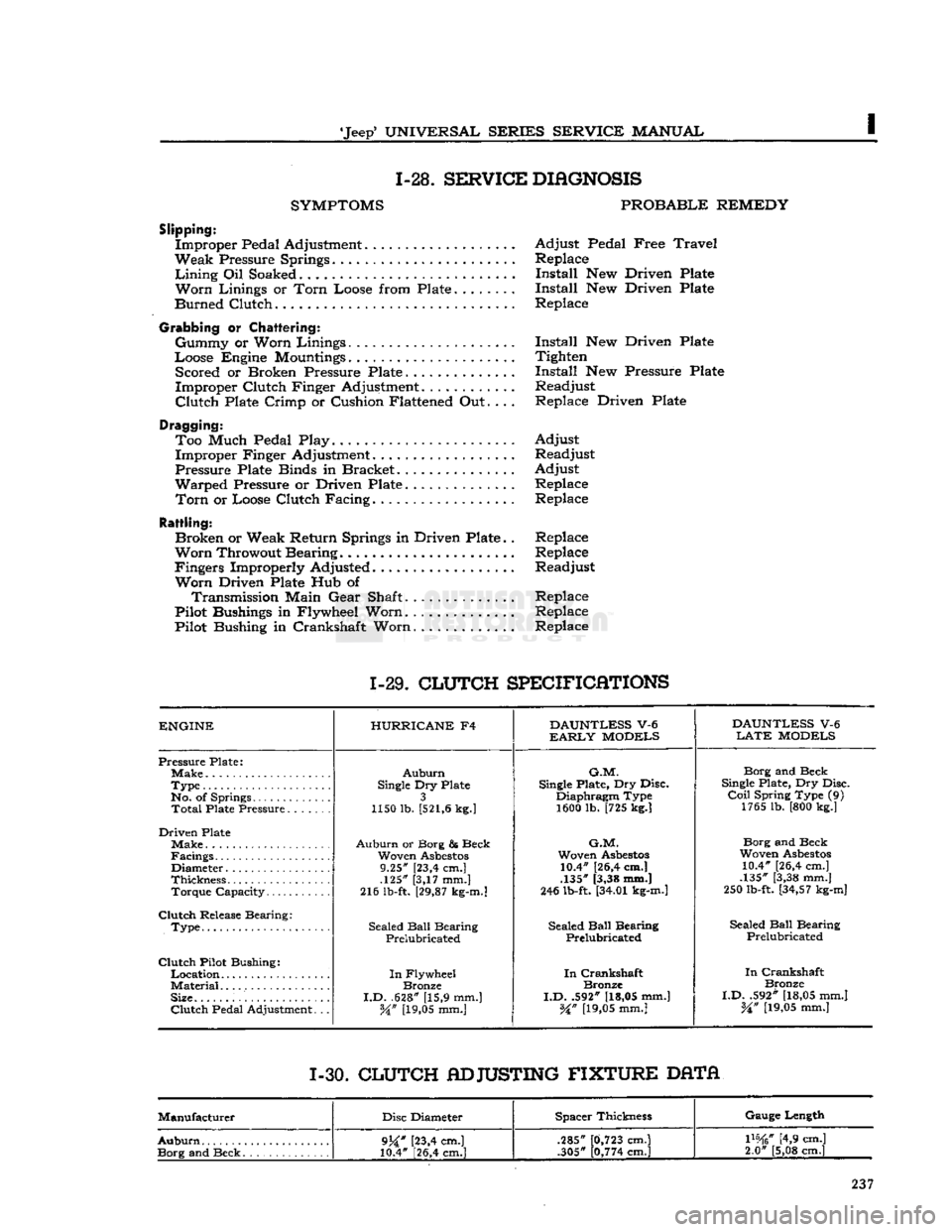
'Jeep'
UNIVERSAL
SERIES
SERVICE
MANUAL
I
1-28.
SERVICE
DIAGNOSIS
SYMPTOMS
PROBABLE
REMEDY
Slipping:
Improper Pedal Adjustment Adjust Pedal Free
Travel
Weak Pressure Springs Replace
Lining
Oil Soaked Install New Driven Plate
Worn
Linings or
Torn
Loose from Plate Install New Driven Plate
Burned Clutch Replace
Grabbing
or
Chattering:
Gummy or Worn Linings Install New Driven Plate
Loose Engine
Mountings
Tighten Scored or Broken Pressure Plate Install New Pressure Plate
Improper Clutch Finger Adjustment............ Readjust
Clutch
Plate Crimp or Cushion Flattened Out.... Replace Driven Plate
Dragging: Too Much Pedal Play. Adjust Improper Finger Adjustment. Readjust
Pressure Plate Binds in Bracket Adjust
Warped Pressure or Driven Plate Replace
Torn
or Loose Clutch Facing. Replace
Rattling:
Broken or Weak Return Springs in Driven Plate.. Replace
Worn
Throwout Bearing Replace
Fingers Improperly Adjusted Readjust
Worn
Driven Plate Hub of Transmission Main Gear Shaft.............. Replace
Pilot Bushings in Flywheel Worn.
.............
Replace
Pilot Bushing in Crankshaft Worn Replace
1-29.
CLUTCH
SPECIFICATIONS
ENGINE
HURRICANE
F4
DAUNTLESS
V-6
DAUNTLESS
V-6
EARLY
MODELS
LATE
MODELS
Pressure Plate;
Auburn
G.M.
Borg and Beck
Type
Single
Dry Plate
Single
Plate, Dry Disc.
Single
Plate, Dry Disc.
No. of Springs 3 Diaphragm Type
Coil
Spring Type (9)
Total
Plate Pressure 1150 lb.
[521,6
kg.]
1600 lb. [725 kg.] 1765 lb. [800 kg.]
Driven Plate Make
Auburn
or Borg & Beck
G.M.
Borg and Beck
Facings Woven
Asbestos
Woven
Asbestos
Woven
Asbestos
Diameter 9.25" [23,4 cm.] 10.4" [26,4 cm.]
10.4" [26,4 cm.]
Thickness .125" [3,17 mm.] .135" [3,38 mm.]
.135" [3,38 mm.]
Torque Capacity 216 lb-ft.
[29,87
kg-m.]
246 lb-ft.
[34.01
kg-m.]
250 lb-ft.
[34,57
kg-m]
Clutch
Release Bearing: Sealed
Ball
Bearing
.
Type Sealed
Ball
Bearing Sealed
Ball
Bearing Sealed
Ball
Bearing
.
Type
Prelubricated Prelubricated
Prelubricated
Clutch
Pilot Bushing:
In
Crankshaft
In
Flywheel
In
Crankshaft
In
Crankshaft
Material
Bronze Bronze
Bronze
Size.
I.D.
.628" [15,9 mm.]
I.D.
.592"
[18,05
mm.]
I.D.
.592"
[18,05
mm.]
Clutch
Pedal Adjustment. .. W
[19,05
mm.]
%n
[19,05
mm.]
%n
[19,05
mm.]
1-30.
CLUTCH
ADJUSTING
FIXTURE
DATA
Manufacturer Disc Diameter Spacer Thickness Gauge Length
Auburn
9j£"
[23,4 cm.]
10.4" [26,4 cm.] .285"
.305"
0,723
cm.]
0,774
cm.]
mtf
[4,9 cm.]
2.0" [5,08 cm.]
9j£"
[23,4 cm.]
10.4" [26,4 cm.] .285"
.305"
0,723
cm.]
0,774
cm.]
mtf
[4,9 cm.]
2.0" [5,08 cm.]
Page 241 of 376
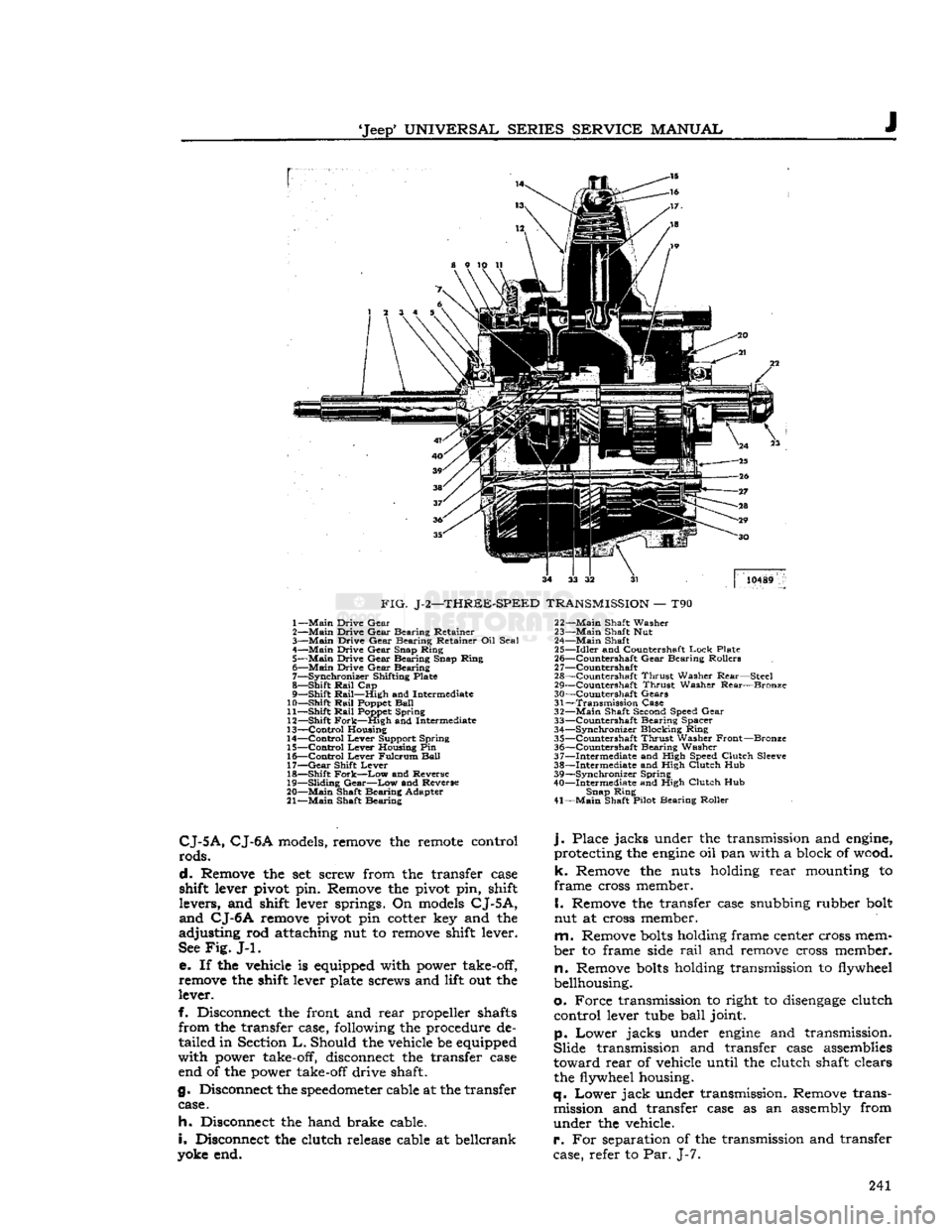
'Jeep'
UNIVERSAL
SERIES
SERVICE
MANUAL
J
10489
FIG.
J-2—THREE-SPEED
TRANSMISSION
— T90 1—
Main
Drive
Gear
2—
Main
Drive
Gear
Bearing
Retainer
3—
Main
Drive
Gear
Bearing
Retainer Oil
Seal
4—
Main
Drive
Gear
Snap
Ring
5—
Main
Drive
Gear
Bearing
Snap
Ring
6—
Main
Drive
Gear
Bearing
7—
Synchronizer
Shifting Plate
8—
Shift
Rail
Cap
9—
Shift
Rail—High
and Intermediate
10—
Shift
Rail
Poppet
Ball
11—
Shift
Rail
Poppet
Spring
12—
Shift
Fork—High
and Intermediate
13—
Control
Housing
14—
Control
Lever
Support
Spring
15—
Control
Lever
Housing Pin
16—
Control
Lever
Fulcrum
Ball
17—
Gear
Shift
Lever
18—
Shift
Fork—Low
and Reverse
19—
Sliding
Gear—Low
and Reverse
20—
Main
Shaft
Bearing
Adapter
21—
Main
Shaft
Bearing
22—
Main
Shaft
Washer
23—
Main
Shaft Nut
24—
Main
Shaft
25—
Idler
and Countershaft
Lock
Plate
26—
^Countershaft
Gear
Bearing
Rollers
2
7—Countershaft
28—
Countershaft
Thrust
Washer
Rear—Steel
29—
Countershaft
Thrust
Washer
Rear—Bronze
30—
Countershaft
Gears
31—
Transmission
Case
32—
Main
Shaft Second Speed
Gear
33—
Countershaft
Bearing
Spacer
34—
Synchronizer
Blocking
Ring
35—
Countershaft
Thrust
Washer
Front—Bronze
36—
Countershaft
Bearing
Washer
37—
Intermediate
and High Speed
Clutch
Sleeve
38—
Intermediate
and High
Clutch
Hub
39—
Synchronizer
Spring
40—
Intermediate
and High
Clutch
Hub
Snap
Ring
41—
Main
Shaft Pilot
Bearing
Roller
CJ-5A,
CJ-6A
models, remove the remote control
rods.
d.
Remove the set screw from the transfer case
shift lever pivot pin. Remove the pivot pin, shift
levers,
and shift lever springs. On models
CJ-5A,
and
CJ-6A
remove pivot pin cotter key and the
adjusting
rod attaching nut to remove shift lever.
See
Fig.
J-l.
e. If the vehicle is equipped with power take-off,
remove the shift lever plate screws and lift out the
lever.
f. Disconnect the front and
rear
propeller shafts
from
the transfer case, following the procedure de
tailed
in Section
L.
Should the vehicle be equipped
with
power take-off, disconnect the transfer case end of the power take-off drive shaft.
g. Disconnect the
speedometer
cable at the transfer case.
h.
Disconnect the hand brake cable.
i.
Disconnect the clutch release cable at beilcrank
yoke end.
j.
Place
jacks
under the transmission and engine,
protecting the
engine
oil pan with a block of wood,
k.
Remove the nuts holding
rear
mounting to
frame
cross member.
I.
Remove the transfer case snubbing rubber bolt
nut at cross member.
m.
Remove
bolts
holding frame center cross mem
ber
to frame side
rail
and remove cross member,
n.
Remove
bolts
holding transmission to flywheel
bellhousing.
o.
Force
transmission to right to
disengage
clutch
control
lever tube
ball
joint.
p.
Lower
jacks
under
engine
and transmission.
Slide
transmission and transfer case assemblies
toward
rear
of vehicle until the clutch shaft clears the flywheel housing.
q.
Lower
jack
under transmission. Remove trans mission and transfer case as an assembly from
under
the vehicle.
r.
For separation of the transmission and transfer
case, refer to Par. J-7. 241
Page 242 of 376
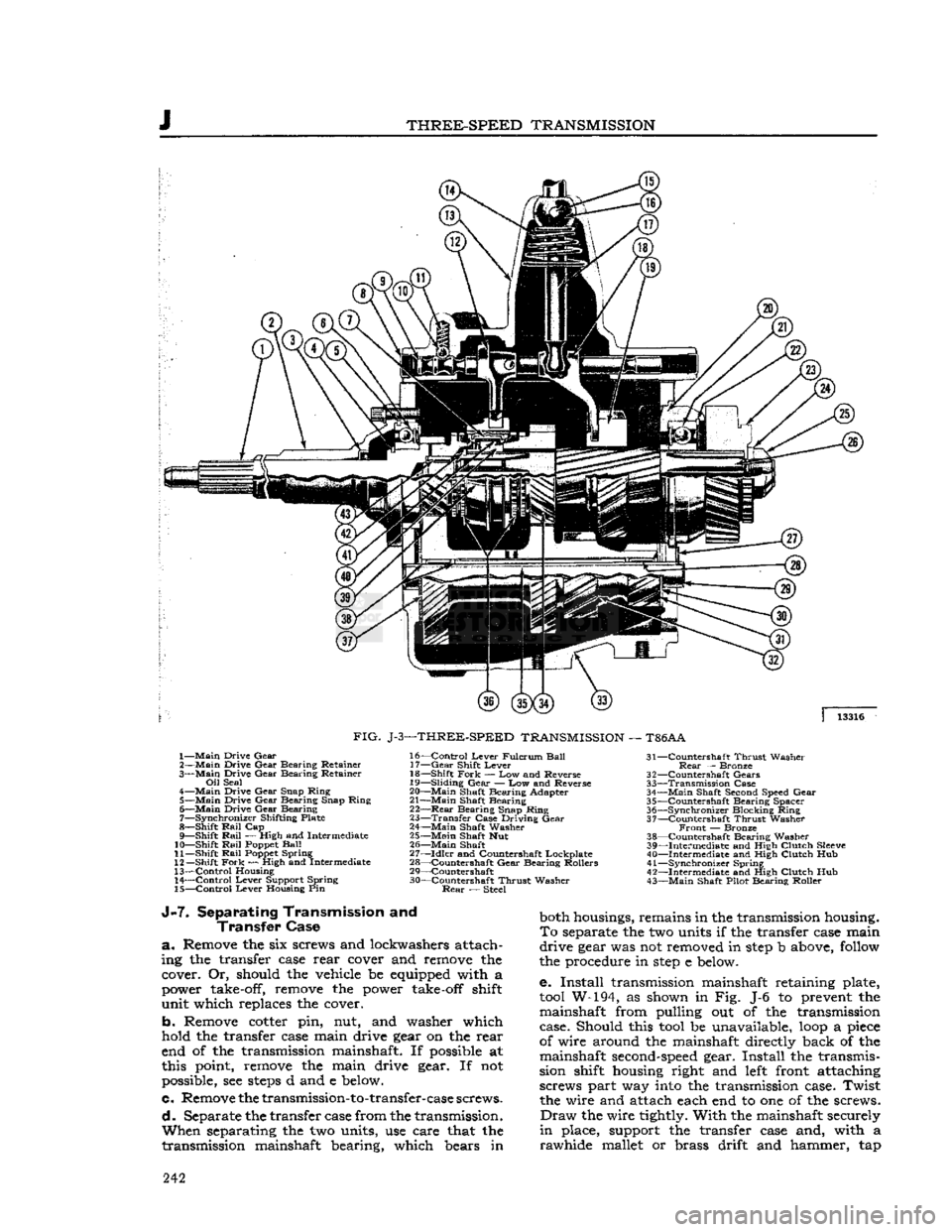
THREE-SPEED
TRANSMISSION
FIG.
J-3—THREE-SPEED
TRANSMISSION
—
T86AA
1—
Main
Drive
Gear
2—
Main
Drive
Gear
Bearing Retainer
3—
Main
Drive
Gear
Bearing Retainer
Oil
Seal
4—
Main
Drive
Gear
Snap Ring
5—
Main
Drive
Gear
Bearing Snap Ring
6—
Main
Drive
Gear
Bearing 7— Synchronizer Shifting Plate
8— Shift
Rail
Cap
9— Shift
Rail
— High and Intermediate
10— Shift
Rail
Poppet
Ball
11— Shift
Rail
Poppet
Spring
12— Shift
Fork
— High and Intermediate
13—
Control
Housing 14—
Control
Lever Support Spring
15—
Control
Lever Housing Pin 16—
Control
Lever
Fulcrum
Ball
17—
Gear
Shift Lever
18— Shift
Fork
— Low and Reverse
19— Sliding
Gear
— Low and Reverse
20—
Main
Shaft Bearing Adapter 21—
Main
Shaft Bearing
22—
Rear
Bearing Snap Ring
23—
Transfer
Case Driving
Gear
24—
Main
Shaft Washer
25—Main Shaft Nut
26—
Main
Shaft
27—
Idler
and Countershaft Lockplate
28— Countershaft
Gear
Bearing Rollers
29— Countershaft
30— Countershaft Thrust Washer
Rear
— Steel 31— Countershaft Thrust Washer
Rear
— Bronze
32— Countershaft Gears
33—
Transmission
Case
34—
Main
Shaft Second Speed
Gear
35— Countershaft Bearing Spacer
36— Synchronizer Blocking Ring 37— Countershaft Thrust Washer
Front
— Bronze
38— Countershaft Bearing Washer
39— Intermediate and High Clutch
Sleeve
40— Intermediate and High Clutch Hub
41
—Synchronizer Spring
42— Intermediate and High Clutch Hub
43—
Main
Shaft Pilot Bearing Roller J-7.
Separating Transmission
and
Transfer Case
a.
Remove the six screws and lockwashers attach
ing the transfer case rear cover and remove the cover. Or, should the vehicle be equipped with a
power
take-off,
remove the power take-off shift
unit which replaces the cover.
b. Remove
cotter
pin, nut, and washer which
hold the transfer case main drive gear on the rear
end of the transmission mainshaft. If
possible
at
this point, remove the main drive gear. If not possible, see
steps
d and e
below.
c. Remove the transmission-to-transfer-case screws.
d.
Separate the transfer case from the transmission.
When separating the two units, use care that the
transmission mainshaft bearing, which bears in
both
housings, remains in the transmission housing.
To
separate the two units if the transfer case main
drive gear was not removed in
step
b
above,
follow
the procedure in
step
e
below.
e.
Install transmission mainshaft retaining plate,
tool
W-194, as shown in Fig. J-6 to prevent the mainshaft from pulling out of the transmission
case. Should this
tool
be unavailable,
loop
a
piece
of wire around the mainshaft directly back of the mainshaft
second-speed
gear. Install the transmis
sion shift housing right and
left
front attaching
screws part way
into
the transmission case. Twist
the wire and attach each end to one of the screws.
Draw
the wire tightly. With the mainshaft securely
in
place, support the transfer case and, with a rawhide mallet or brass drift and hammer, tap 242
Page 244 of 376
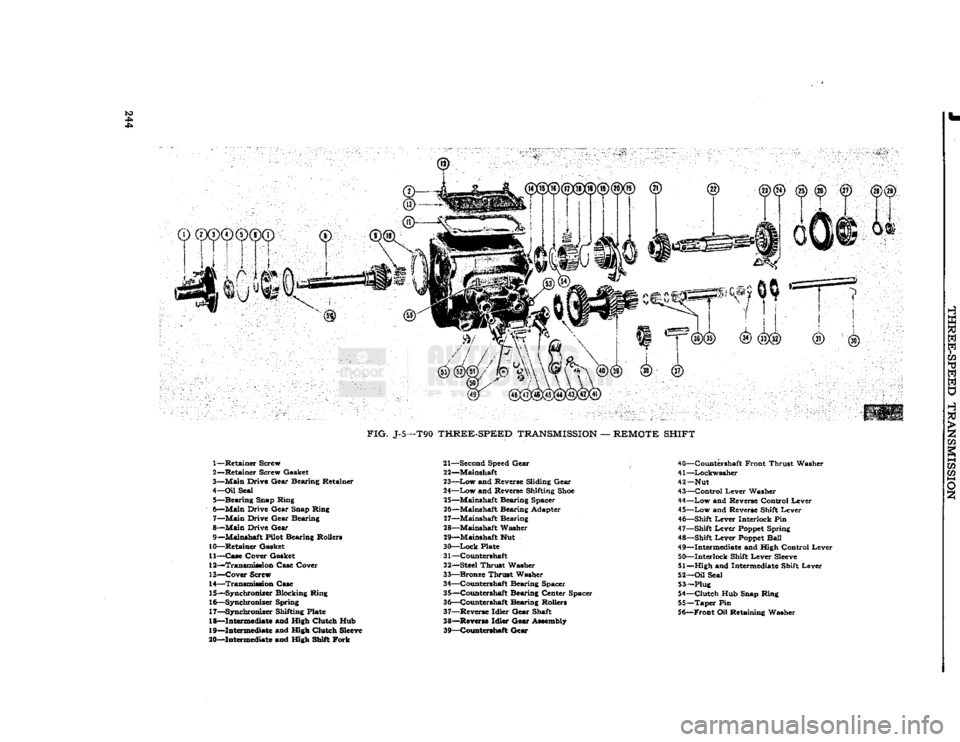
1— Retainer Screw
2— Retainer Screw Gasket
3—
Main
Drive Gear Bearing Retainer
4—
Oil
Seal 5— Bearing Snap Ring
6—
Main
Drive Gear Snap Ring 7—
Main
Drive Gear Bearing
8—
Main
Drive Gear
9— Mainshaft Pilot Bearing Rollers
10— Retainer Gasket
11—
Case
Cover Gasket 12—Transmission Case Cover
13—
Cover
Screw
14— Transmission Case 15— Synchronizer Blocking Ring
16— Synchronizer Spring
17— Synchronizer Shifting Plate
18— Intermediate and High Clutch Hub
19—
Intermediate
and High Clutch
Sleeve
20— Intermediate and High Shift
Fork
21—
Second
Speed
Gear
22— Mainshaft
23—
Low
and Reverse Sliding Gear 24—
Low
and Reverse Shifting
Shoe
25— Mainshaft Bearing Spacer
26— Mainshaft Bearing Adapter
27— Mainshaft Bearing
28— Mainshaft Washer
29— Mainshaft Nut
30—
Lock
Plate
31— Countershaft
32—
Steel
Thrust Washer
33— Bronze Thrust Washer
34— Countershaft Bearing Spacer
35— Countershaft Bearing Center Spacer
36— Countershaft Bearing Rollers
37— Reverse Idler Gear Shaft
38— Reverse Idler Gear Assembly
39— Countershaft Gear 40— Countershaft Front Thrust Washer
41—
Lockwasher
42— Nut
43—
Control
Lever Washer
44—
Low
and Reverse Control Lever
45—
Low
and Reverse Shift Lever
46— Shift Lever Interlock Pin
47— Shift Lever
Poppet
Spring
48— Shift Lever
Poppet
Ball
49— Intermediate and High Control Lever 50— Interlock Shift Lever
Sleeve
51— High and Intermediate Shift Lever
52—
Oil
Seal 53— Plug
54—
Clutch
Hub Snap Ring 55—
Taper
Pin
56—
Front
Oil Retaining Washer
Page 245 of 376
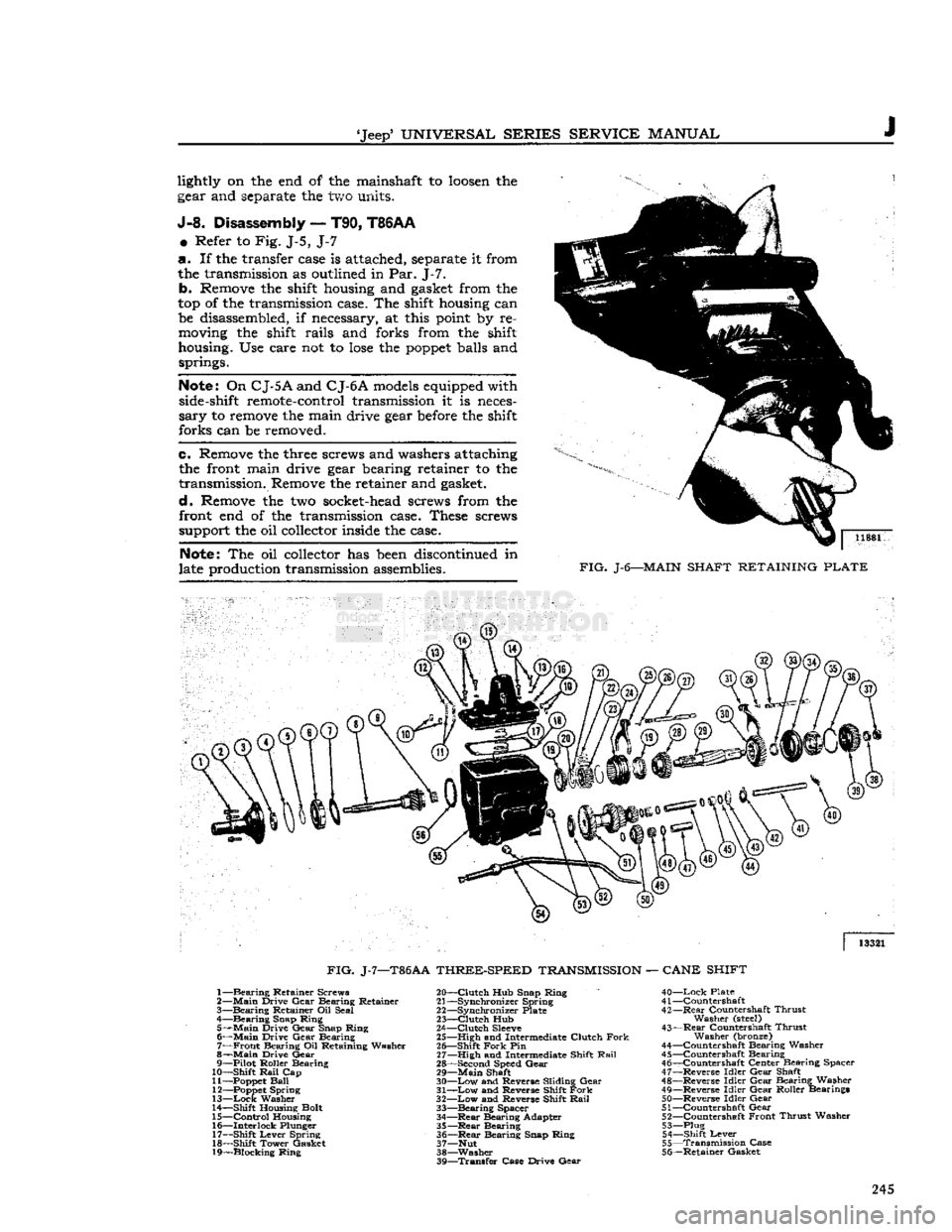
'Jeep*
UNIVERSAL
SERIES'
SERVICE
MANUAL
lightly
on the end of the
mainshaft
to
loosen
the
gear
and
separate
the two
units.
J-8.
Disassembly
—
T90,
T86AA
®
Refer to Fig. J-5, J-7
a. If the transfer
case
is
attached,
separate
it from
the
transmission
as
outlined
in Par. J-7. b.
Remove
the
shift
housing
and
gasket
from the
top of the
transmission
case.
The
shift
housing
can
be
disassembled,
if
necessary,
at
this
point
by re
moving
the
shift
rails and forks from the
shift
housing.
Use care not to
lose
the
poppet
balls
and
springs.
Note;
On
CJ-5
A
and
C
J-6A
models
equipped
with
side-shift
remote-control
transmission
it is
neces
sary to
remove
the main drive
gear
before
the
shift
forks can be
removed.
e.
Remove
the
three
screws
and
washers
attaching
the
front
main drive
gear
bearing
retainer to the
transmission.
Remove
the retainer and
gasket,
d.
Remove
the two
socket-head
screws
from the
front
end of the
transmission
case.
These
screws
support
the oil
collector
inside
the
case.
Note:
The oil
collector
has
been
discontinued
in
late
production
transmission
assemblies.
11881
FIG.
J-6—MAIN
SHAFT
RETAINING
PLATE
13321
FIG.
J-7—T86AA
THREE-SPEED
TRANSMISSION
—
CANE
SHIFT
1—
Bearing
Retainer Screws
2—
Main
Drive Gear Bearing Retainer
3—
Bearing
Retainer Oil Seal
,
4—Bearing Snap Ring
5—
Main
Drive Gear Snap Ring 6—
Main
Drive Gear Bearing 7—
Front
Bearing Oil Retaining Washer
8—
Main
Drive Gear
9— Pilot Roller Bearing
10— Shift
Rail
Cap
11—
Poppet
Ball
12—
Poppet
Spring
13—
Lock
Washer
14— Shift Housing Bolt
15—
Control
Housing 16— Interlock Plunger
17— Shift Lever Spring
18— Shift Tower Gasket
19— Blocking Ring 20—
Clutch
Hub Snap Ring
21— Synchronizer Spring
22— Synchronizer Plate
23—
Clutch
Hub
24—
Clutch
Sleeve
25— High and Intermediate Clutch
Fork
26— Shift
Fork
Pin
27— High and Intermediate Shift
Rail
28— Second Speed Gear 29—
Main
Shaft
30—
Low
and Reverse Sliding Gear
31—
Low
and Reverse Shift
Fork
32—
Low
and Reverse Shift
Rail
33—
Bearing
Spacer
34—
—Rear
Bearing Adapter
35—Rear
Bearing 36—
Rear
Bearing Snap Ring
37— Nut
38—Washer 39—
Transfer
Case Drive Gear
40—Lock
Plate
41 —Countershaft
42—
Rear
Countershaft Thrust Washer
(steel)
43—
Rear
Countershaft Thrust Washer (bronze)
44— Countershaft Bearing Washer
45— Countershaft Bearing 46— Countershaft Center Bearing Spacer
47— Reverse Idler Gear Shaft
48— Reverse Idler Gear Bearing Washer
49— Reverse Idler Gear Roller Bearings 50— Reverse Idler Gear
51— Countershaft Gear 52— Countershaft Front Thrust Washer
53— Plug 54— Shift Lever
55—
Transmission
Case
56— Retainer Gasket 245
Page 246 of 376
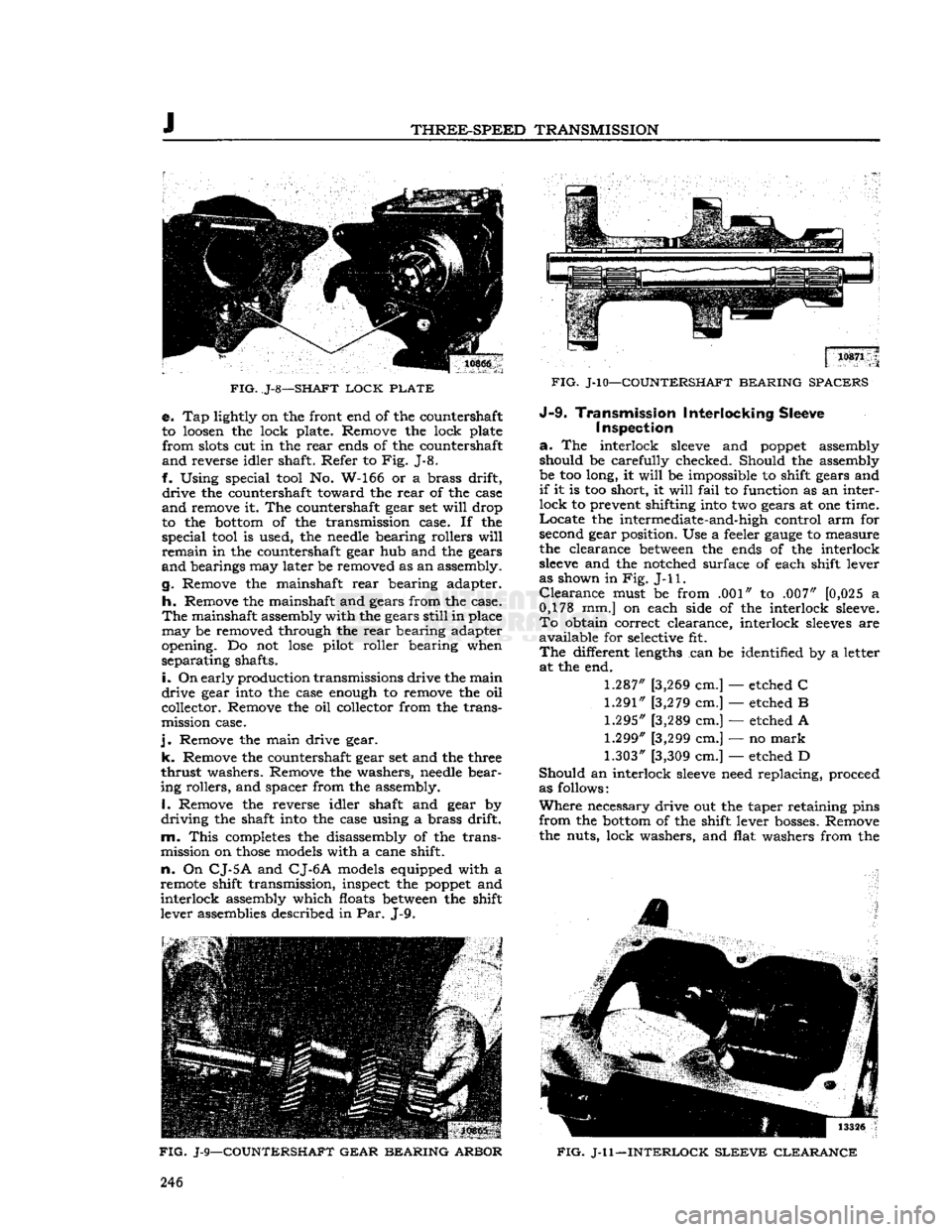
J
THREE-SPEED
TRANSMISSION
FIG.
J-8—SHAFT
LOCK
PLATE
e. Tap lightly on the front end of the countershaft
to loosen the lock plate. Remove the lock plate
from
slots cut in the
rear
ends of the countershaft
and
reverse idler shaft. Refer to Fig. J-8.
f. Using special tool No. W-166 or a brass drift,
drive
the countershaft toward the
rear
of the case
and
remove it. The countershaft gear set
will
drop
to the bottom of the transmission case. If the
special
tool is used, the needle bearing rollers
will
remain
in the countershaft gear hub and the gears
and
bearings may later be removed as an assembly.
g. Remove the mainshaft
rear
bearing adapter.
h.
Remove the mainshaft and gears from the case.
The
mainshaft assembly with the gears
still
in place
may
be removed through the
rear
bearing adapter
opening. Do not
lose
pilot roller bearing when
separating
shafts.
i.
On
early production transmissions drive the main
drive
gear into the case enough to remove the oil
collector. Remove the oil collector from the trans
mission case.
j.
Remove the main drive gear,
k.
Remove the countershaft gear set and the three
thrust
washers. Remove the washers, needle bear
ing rollers, and spacer from the assembly. 1, Remove the reverse idler shaft and gear by
driving
the shaft into the case using a brass drift,
m.
This
completes the disassembly of the trans
mission on
those
models with a cane shift,
n.
On
CJ-5
A
and
CJ-6 A
models equipped with a
remote shift transmission, inspect the poppet and
interlock
assembly which floats between the shift
lever assemblies described in Par. J-9.
FIG.
J-9—COUNTERSHAFT GEAR BEARING ARBOR
FIG.
J-l0—COUNTERSHAFT BEARING SPACERS J-9-
Transmission Interlocking Sleeve
I
inspection
a.
The interlock
sleeve
and poppet assembly should be carefully checked. Should the assembly
be too long, it
will
be impossible to shift gears and
if
it is too short, it
will
fail
to function as an inter
lock
to prevent shifting into two gears at one time.
Locate
the intermediate-and-high control arm for
second gear position. Use a feeler
gauge
to measure
the clearance between the ends of the interlock
sleeve
and the notched surface of each shift lever
as shown in Fig.
J-l
1.
Clearance
must be from .001" to .007" [0,025 a
0,178 mm.] on each side of the interlock sleeve.
To
obtain correct clearance, interlock
sleeves
are
available
for selective fit.
The
different lengths can be identified by a letter at the end.
1.287"
[3,269 cm.] — etched C
1.291"
[3,279 cm.] — etched B
1.295"
[3,289 cm.] — etched A
1.299"
[3,299 cm.] — no
mark
1.303"
[3,309 cm.] — etched D
Should
an interlock
sleeve
need replacing, proceed
as follows:
Where
necessary drive out the taper retaining pins
from
the bottom of the shift lever bosses. Remove
the nuts, lock washers, and flat washers from the
4
FIG.
J-l 1—INTERLOCK
SLEEVE
CLEARANCE
246
Page 247 of 376
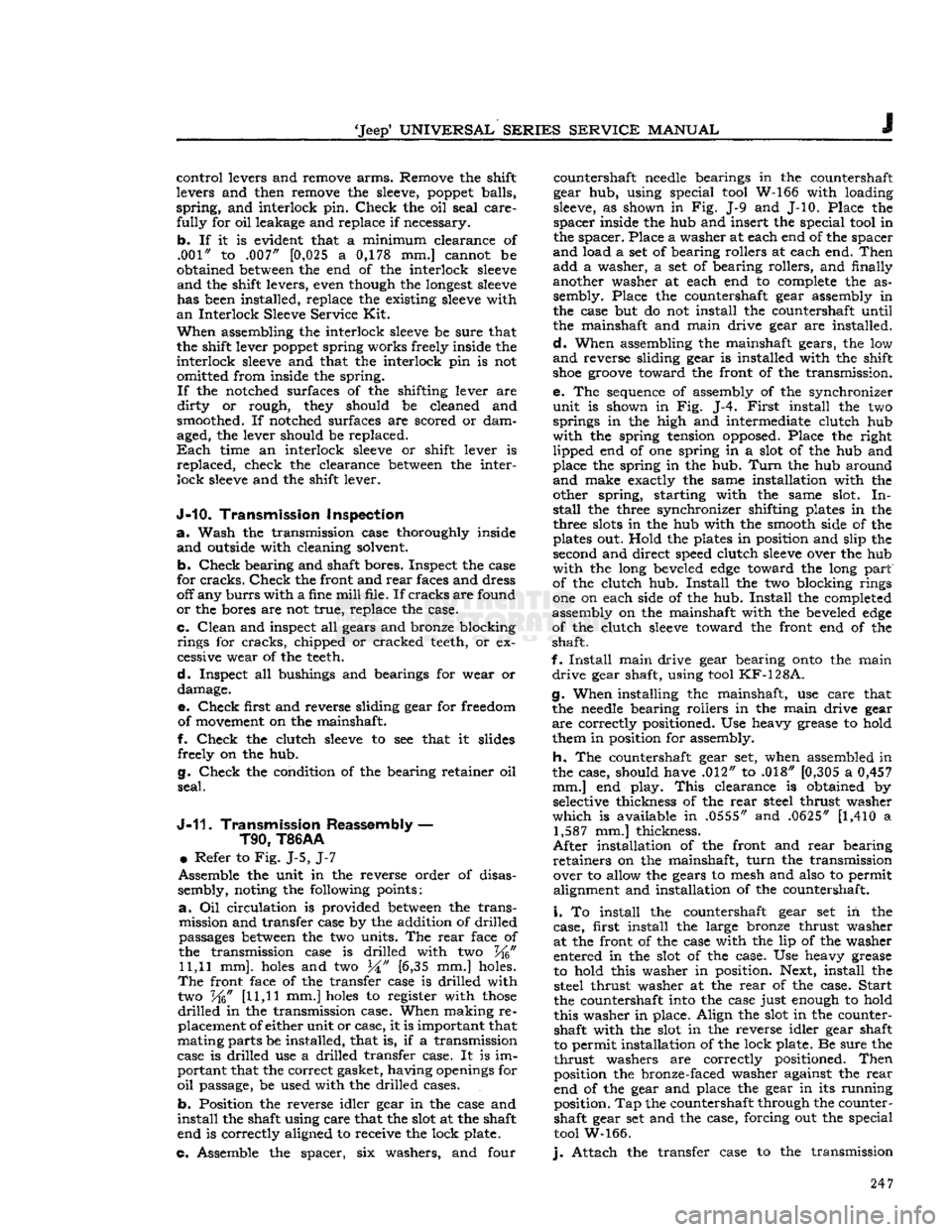
'Jeep*
UNIVERSAL
SERIES SERVICE
MANUAL
J
control
levers and remove arms. Remove the shift
levers and then remove the
sleeve,
poppet
balls,
spring,
and interlock pin.
Check
the oil seal care
fully
for oil leakage and replace if necessary,
b.
If it is evident that a minimum clearance of .001" to .007" [0,025 a 0,178 mm.] cannot be
obtained
between
the end of the interlock
sleeve
and
the shift levers, even though the
longest
sleeve
has been installed, replace the existing
sleeve
with
an
Interlock Sleeve Service Kit.
When
assembling the interlock
sleeve
be sure that
the shift lever
poppet
spring works freely inside the
interlock
sleeve
and that the interlock pin is not
omitted from inside the spring.
If
the notched surfaces of the shifting lever are
dirty
or rough, they should be cleaned and
smoothed. If notched surfaces are scored or dam
aged, the lever should be replaced.
Each
time an interlock
sleeve
or shift lever is
replaced,
check the clearance
between
the inter
lock
sleeve
and the shift lever.
J-10.
Transmission
Inspection
a.
Wash the transmission case thoroughly inside
and
outside with cleaning solvent.
b.
Check
bearing and shaft bores. Inspect the case
for
cracks.
Check
the front and
rear
faces and dress
off any
burrs
with a fine
mill
file. If
cracks
are found
or
the bores are not true, replace the case.
c.
Clean
and inspect all gears and bronze blocking
rings for
cracks,
chipped or cracked teeth, or excessive wear of the teeth.
d.
Inspect all bushings and bearings for wear or damage.
e.
Check
first and reverse sliding gear for freedom of movement on the mainshaft.
f.
Check
the clutch
sleeve
to see that it slides freely on the hub.
g.
Check
the condition of the bearing retainer oil
seal.
J-11.
Transmission
Reassembly
—
T90,
T86AA
•
Refer to Fig. J-5, J-7
Assemble the unit in the reverse order of disas
sembly, noting the following points:
a.
Oil circulation is provided
between
the trans mission and transfer case by the addition of drilled
passages
between
the two units. The
rear
face of
the transmission case is drilled with two %" 11,11 mm],
holes
and two [6,35 mm.] holes.
The
front face of the transfer case is drilled with
two %"
[11,11
mm.]
holes
to register with
those
drilled
in the transmission case. When making re
placement of either unit or case, it is important that
mating parts be installed, that is, if a transmission
case is drilled use a drilled transfer case. It is im
portant that the correct gasket, having
openings
for
oil
passage, be used with the drilled cases.
b.
Position the reverse idler gear in the case and
install
the shaft using care that the slot at the shaft end is correctly aligned to receive the lock plate.
c. Assemble the spacer, six washers, and four countershaft
needle
bearings in the countershaft
gear hub, using special tool W-166 with loading
sleeve,
as shown in Fig. J-9 and J-10. Place the
spacer
inside the hub and insert the special tool in
the spacer. Place a washer at each end of the spacer
and
load a set of bearing rollers at each end.
Then
add
a washer, a set of bearing rollers, and finally
another washer at each end to complete the as sembly. Place the countershaft gear assembly in
the case but do not install the countershaft until
the mainshaft and main drive gear are installed.
d.
When assembling the mainshaft gears, the low
and
reverse sliding gear is installed with the shift
shoe
groove
toward the front of the transmission.
e. The sequence of assembly of the synchronizer
unit
is shown in Fig. J-4.
First
install the two springs in the high and intermediate clutch hub
with
the spring tension opposed. Place the right lipped end of one spring in a slot of the hub and
place the spring in the hub.
Turn
the hub around
and
make exactly the same installation with the other spring, starting with the same slot. In
stall
the three synchronizer shifting plates in the
three
slots
in the hub with the smooth side of the
plates out. Hold the plates in position and slip the second and direct speed clutch
sleeve
over the hub
with
the long beveled
edge
toward the long part
of the clutch hub.
Install
the two blocking rings
one on each side of the hub.
Install
the completed
assembly on the mainshaft with the beveled
edge
of the clutch
sleeve
toward the front end of the
shaft.
f.
Install
main drive gear bearing
onto
the main
drive
gear shaft, using tool
KF-128A.
g.
When installing the mainshaft, use care that the
needle
bearing rollers in the main drive gear
are
correctly positioned. Use heavy grease to hold
them in position for assembly.
h.
The countershaft gear set, when assembled in
the case, should have .012" to .018" [0,305 a
0,457
mm.] end play.
This
clearance is obtained by selective thickness of the
rear
steel thrust washer
which
is available in .0555" and .0625"
[1,410
a 1,587 mm.] thickness.
After
installation of the front and
rear
bearing
retainers
on the mainshaft,
turn
the transmission over to allow the gears to mesh and also to permit alignment and installation of the countershaft.
i.
To install the countershaft gear set in the
case, first install the large bronze thrust washer
at the front of the case with the lip of the washer
entered in the slot of the case. Use heavy grease to hold this washer in position. Next, install the steel thrust washer at the
rear
of the case.
Start
the countershaft into the case just enough to hold
this washer in place. Align the slot in the counter shaft with the slot in the reverse idler gear shaft
to permit installation of the lock plate. Be sure the
thrust
washers are correctly positioned.
Then
position the bronze-faced washer against the
rear
end of the gear and place the gear in its running
position.
Tap
the countershaft through the countershaft gear set and the case, forcing out the special
tool W-166.
j.
Attach the transfer case to the transmission 247
Page 248 of 376
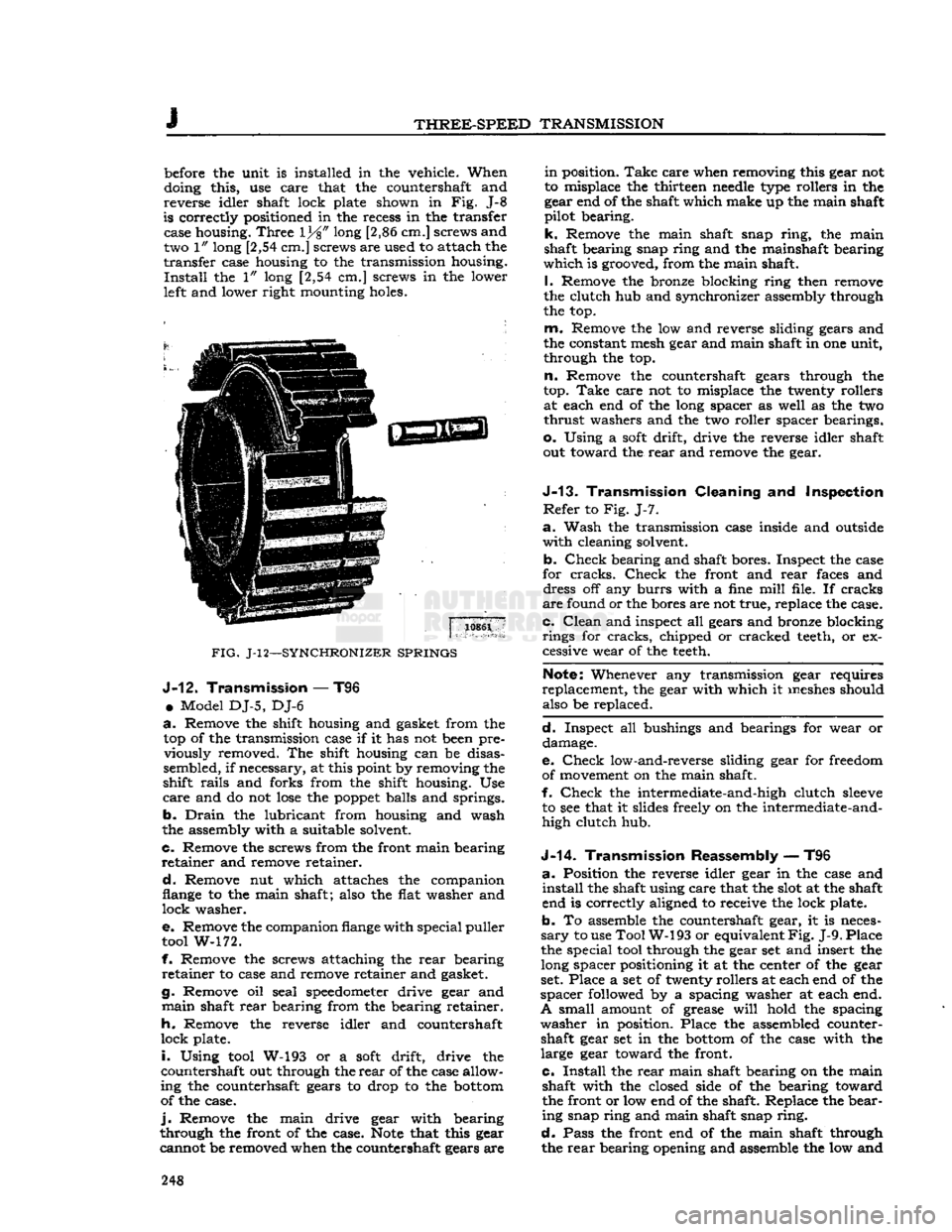
J
THREE-SPEED
TRANSMISSION
before
the unit is installed in the vehicle. When
doing this, use care that the countershaft and
reverse
idler shaft lock plate shown in Fig. J-8
is correctly positioned in the recess in the transfer case housing.
Three
\
Y%"
long [2,86 cm.] screws and
two 1" long [2,54 cm.] screws are used to attach the
transfer
case housing to the transmission housing.
Install
the 1" long [2,54 cm.] screws in the lower
left
and lower right mounting holes.
FIG.
J-12—SYNCHRONIZER
SPRINGS
J-12.
Transmission — T96
•
Model DJ-5, DJ-6
a.
Remove the shift housing and gasket from the top of the transmission case if it has not
been
pre viously removed. The shift housing can be disas
sembled, if necessary, at this point by removing the
shift
rails
and forks from the shift housing. Use
care
and do not
lose
the
poppet
balls and springs.
b.
Drain
the lubricant from housing and wash
the assembly with a suitable solvent.
c.
Remove the screws from the front main bearing
retainer
and remove retainer.
d.
Remove nut which attaches the companion
flange
to the main shaft; also the flat washer and
lock
washer.
e.
Remove the companion
flange
with special puller
tool
W-172.
f. Remove the screws attaching the
rear
bearing
retainer
to case and remove retainer and gasket.
g. Remove oil seal
speedometer
drive gear and
main
shaft
rear
bearing from the bearing retainer.
h.
Remove the reverse idler and countershaft
lock
plate.
i.
Using
tool
W-193 or a
soft
drift, drive the
countershaft out through the
rear
of the case allow
ing the counterhsaft gears to drop to the
bottom
of the case.
j.
Remove the main drive gear with bearing
through the front of the case.
Note
that this gear cannot be removed when the countershaft gears are
in
position.
Take
care when removing this gear not
to misplace the thirteen
needle
type
rollers in the
gear end of the shaft which make up the main shaft
pilot bearing.
k.
Remove the main shaft snap
ring,
the main
shaft bearing snap ring and the mainshaft bearing
which
is grooved, from the main shaft.
I.
Remove the bronze blocking ring then remove
the clutch hub and synchronizer assembly through
the top.
m.
Remove the low and reverse sliding gears and
the constant mesh gear and main shaft in one unit,
through the top.
n.
Remove the countershaft gears through the
top.
Take
care not to misplace the twenty rollers at each end of the long spacer as well as the two
thrust
washers and the two roller spacer bearings,
o.
Using a
soft
drift, drive the reverse idler shaft
out toward the
rear
and remove the gear.
J-13.
Transmission Cleaning and Inspection
Refer
to Fig. J-7.
a.
Wash the transmission case inside and
outside
with
cleaning solvent.
b.
Check
bearing and shaft bores. Inspect the case
for
cracks.
Check
the front and
rear
faces
and dress off any
burrs
with a fine
mill
file. If cracks
are
found or the bores are not true, replace the case.
c.
Clean
and inspect all gears and bronze blocking
rings
for
cracks,
chipped or cracked
teeth,
or ex
cessive wear of the
teeth.
Note:
Whenever any transmission gear requires
replacement, the gear with which it
meshes
should also be replaced.
d.
Inspect all bushings and bearings for wear or damage.
e.
Check
low-and-reverse sliding gear for freedom
of
movement
on the main shaft.
f.
Check
the intermediate-and-high clutch
sleeve
to see that it slides freely on the intermediate-and-
high clutch hub.
J-14. Transmission Reassembly
—-
T96
a.
Position the reverse idler gear in the case and
install
the shaft using care that the
slot
at the shaft
end is correctly aligned to receive the lock plate.
b.
To assemble the countershaft gear, it is neces
sary
to use Tool W-193 or equivalent
Fig. J-9.
Place
the special
tool
through the gear set and insert the
long spacer positioning it at the center of the gear
set. Place a set of twenty rollers at each end of the
spacer
followed by a spacing washer at each end.
A
small amount of grease
will
hold the spacing
washer
in position. Place the assembled counter shaft gear set in the
bottom
of the case with the
large gear toward the front.
C*
Install
the
rear
main shaft bearing on the main shaft with the closed side of the bearing toward
the front or low end of the shaft. Replace the bear
ing snap ring and main shaft snap
ring,
d.
Pass the front end of the main shaft through the
rear
bearing opening and assemble the low and 248